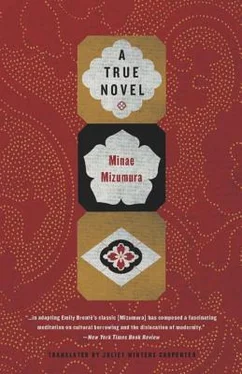Minae Mizumura - A True Novel
Здесь есть возможность читать онлайн «Minae Mizumura - A True Novel» весь текст электронной книги совершенно бесплатно (целиком полную версию без сокращений). В некоторых случаях можно слушать аудио, скачать через торрент в формате fb2 и присутствует краткое содержание. Год выпуска: 2013, Издательство: Other Press, Жанр: Современная проза, на английском языке. Описание произведения, (предисловие) а так же отзывы посетителей доступны на портале библиотеки ЛибКат.
- Название:A True Novel
- Автор:
- Издательство:Other Press
- Жанр:
- Год:2013
- ISBN:нет данных
- Рейтинг книги:4 / 5. Голосов: 1
-
Избранное:Добавить в избранное
- Отзывы:
-
Ваша оценка:
- 80
- 1
- 2
- 3
- 4
- 5
A True Novel: краткое содержание, описание и аннотация
Предлагаем к чтению аннотацию, описание, краткое содержание или предисловие (зависит от того, что написал сам автор книги «A True Novel»). Если вы не нашли необходимую информацию о книге — напишите в комментариях, мы постараемся отыскать её.
A True Novel
The winner of Japan’s prestigious Yomiuri Literature Prize, Mizumura has written a beautiful novel, with love at its core, that reveals, above all, the power of storytelling.
A True Novel — читать онлайн бесплатно полную книгу (весь текст) целиком
Ниже представлен текст книги, разбитый по страницам. Система сохранения места последней прочитанной страницы, позволяет с удобством читать онлайн бесплатно книгу «A True Novel», без необходимости каждый раз заново искать на чём Вы остановились. Поставьте закладку, и сможете в любой момент перейти на страницу, на которой закончили чтение.
Интервал:
Закладка:
From then on, it was just one thing after another. A few months later, in May 1990, Grampy, who had been in and out of the hospital, died. Around the same time, Yayoi’s uterine cancer returned, apparently triggered by stress from the bicycle accident. The young cyclist had sprinted away, leaving her with a fractured femur that needed surgery. Once the cancer came back it spread right through her, and within six months, in November of that same year, she was gone too. Her death meant that the Shigemitsu family, like the Saegusas before them, would soon face the problem of land inheritance tax, but that wasn’t all. A more immediate problem was Masao, now a widower. He had always seemed to live on nothing but mist. Leaving him on his own was impossible, and since he had no desire to leave Seijo anyway, Yoko and her family ended up selling the Nogizaka condominium and moving to Seijo, along with Masayuki’s architectural firm.
Looking back, that was never a very good idea. When Grampy died, the Saegusa sisters had all the structures on their property torn down and asked Masayuki to design something new: a stylish three-story building for the clan, one that would fit into that exclusive neighborhood and not look like multiple-family housing. The project was completed in spring 1991, a few months after Yoko and her family moved to Seijo. The Saegusas, who had been living in scattered rental apartments during the construction, all moved into the new house, including Natsue, who had been in a condominium near the station. Except for summers in Karuizawa, Yoko had always lived apart from the rest of them, first in Chitose Funabashi, then Sapporo, then Nogizaka, but from now on they were in awkward proximity. Moreover, sadly enough, though she had moved to Seijo for her father-in-law’s sake, he soon developed pancreatic cancer and died early in the winter of 1991. He was seventy-four. For a man, that’s close enough to a full lifespan, but his death coming so soon after Yayoi’s made it seem as though he had willed it to happen. With him gone, I have no doubt that Yoko would have preferred to leave Seijo. For one thing, she was so used to living in her own world that social life was not easy for her. And then there was her involvement with Taro, which the Saegusa sisters looked on so unforgivingly. But Miki was thrilled to be living next door to her cousins. Yoko always felt guilty that her own fragile health had made Miki an only child, and seeing how happy her daughter was in Seijo must have made it difficult to suggest moving. Before long Miki fell in love with Mari’s second son, whose nickname was Nimbo—a nice enough young man in both character and looks, but no scholar. With Miki in love, it became even harder to consider moving, since that might have been taken as a deliberate attempt to quash the romance.
IT WAS THE summer of 1992 when I found out that all was not well with Yoko, whom I had thought supremely happy. That turned out to be her last summer in Karuizawa. It was also when Taro took over the Karuizawa property.
“Aunt Harue always acts as if she owns the whole world,” Yoko would say with a mocking smile. Sometimes the smile would have a tinge of sarcasm. “What if she knew this all belongs to Taro! I’d like to see her face then.”
She was never small-minded, and I’m sure she was genuinely glad for their sakes that the three sisters were able to go on using their Karuizawa villa. But having been tormented by Harue for so long, deep down it must have given her a kick to know that it was thanks to her—or rather thanks to Taro, whom they had once treated as a servant boy—that their holiday was possible. I felt the same secret pleasure; she and I were partners in that.
That summer Yoko’s sister, Yuko, came back to Japan for the first time in a while, together with her daughter Naomi. On her way to the United States to see Taro, Yoko had taken to stopping off in San Francisco, and the two sisters were much closer than they had ever been, though how Yoko explained those frequent trips abroad I have no idea. She had Yuko and Naomi stay in the Shigemitsu villa, not the Saegusa one. The Saegusa attic rooms had been neglected for so long they were no better than storerooms, but with her parents-in-law now gone, the other house had plenty of unused rooms for guests. I worked in the Saegusa household, and from the sound of Yoko next door singing to her sister’s piano accompaniment, I could tell how much she was enjoying not having her aunt around to say snide things like “Now how about a little Callas to cleanse the palate?” During their stay, Yoko was so busy entertaining them and doing things with them that her underlying vexation barely showed.
The day after they went back to San Francisco, Yoko opened the door to the Saegusa kitchen, darted her eyes around the way she used to do as a child, and came in, having made sure I was alone. She sat down at the big table, reached for a pillowcase I had just ironed, and folded it as she talked.
“I envy Yuko,” she said.
In my eyes Yoko would always be a child, but glancing down at her hands as she folded the pillowcase, I saw they were the hands of a housewife, well accustomed to dishwater, with prominent blotches and veins. But she dressed much more carefully than ever before. Perhaps in that respect, being loved by two men made the difference. That day she was wearing a thin linen sweater with a gauzy scarf of gold silk. She somehow looked prettier than when she was young.
When I didn’t react to her remark, she repeated it. “I envy Yuko.”
“Do you?”
“She has more freedom.”
She seemed envious that Yuko lived at such a great distance from the other Saegusas.
“ And she’s got a career.” While her hands folded my ironing, she went on murmuring, half to herself: “I was lazy and never applied myself, so I’ve got nothing like that.”
“You have your interior design work, don’t you?”
“Nobody takes it seriously. And they’re right not to.”
So she knows, I thought, but I kept my head down and went on ironing.
“I wish I had some work that made me feel I was born to do it.”
As times changed and more women entered the workforce, Yoko seemed to regret that she had reached her forties with no skills to speak of. Since she had not been given the same education as her sister, I thought this was not entirely her fault, but I didn’t say so.
Yoko sighed. “Actually, I don’t care so much about myself. It’s Miki, really. If only she were more like Naomi!”
It seemed to embarrass her to run down her own daughter, but I too could see that among the grandchildren Naomi stood out. Unlike her brother Ken, who looked American, Naomi had more Japanese features and wanted to keep up her Japanese language skills. That’s why she had come back that summer, which gave us a chance to get to know her better. Of course, she was a beauty, with a mother like Yuko and a father who looked “like Gérard Philipe.” Even more striking was her figure, which was different from Japanese women’s. If she had grown up in Japan, she would certainly have attracted more attention than she cared for. Eri’s daughter, incidentally, was a tall girl who hoped to become a fashion model—an aspiration her grandmother disapproved of. “What is the child thinking? How vulgar! Why, she’s no different from all those common girls!” But the girl in question couldn’t have cared less what her grandmother said and went about wistfully comparing her measurements with Naomi’s, sighing and saying, “Oh, you’re so lucky!” As for Naomi herself, she wore baggy jeans and cinched her wavy brown hair in a simple ponytail. Usually she could be found in the shade of a tree with her glasses on, reading a book, or sitting at the porch table in front of her computer. She was still only twenty-one, but she had skipped a year of high school and graduated from college a year early, and in the fall she was to enter the medical school of Johns Hopkins University out east. Her goal was to become a medical researcher. Whether this had anything to do with her memory of the Utagawa grandfather whom she knew as a little girl, I don’t know. She also liked collecting insects as much as any boy, and in Karuizawa she would often put on a straw hat and go roaming around the hills by herself, looking for them. Even though she was attached to Japan, the people her age streaming along the Karuizawa Ginza in droves seemed to baffle her. I suspect she felt as if they were from another planet. As a child she’d played happily enough with the Saegusa grandchildren, taking the part of a kindly elder sister, but I could see an emotional gap opening up between them as time went by. She seemed in fact to feel closest to my granddaughter Ami.
Читать дальшеИнтервал:
Закладка:
Похожие книги на «A True Novel»
Представляем Вашему вниманию похожие книги на «A True Novel» списком для выбора. Мы отобрали схожую по названию и смыслу литературу в надежде предоставить читателям больше вариантов отыскать новые, интересные, ещё непрочитанные произведения.
Обсуждение, отзывы о книге «A True Novel» и просто собственные мнения читателей. Оставьте ваши комментарии, напишите, что Вы думаете о произведении, его смысле или главных героях. Укажите что конкретно понравилось, а что нет, и почему Вы так считаете.












